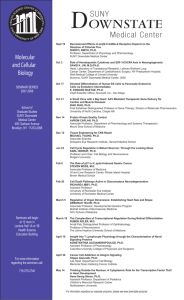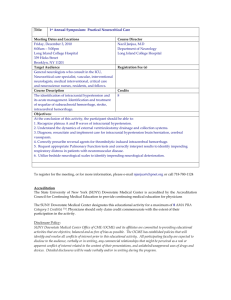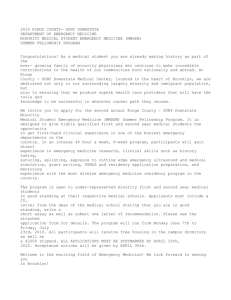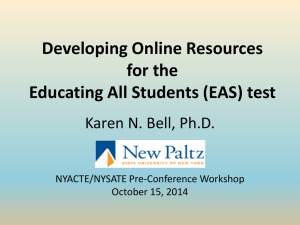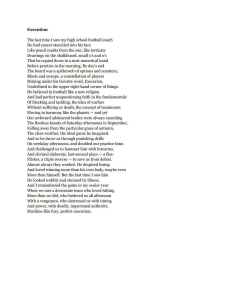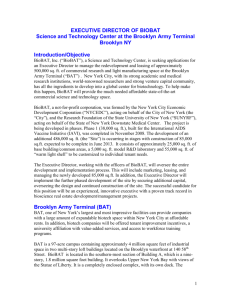Downstate White Paper – 2_1
advertisement
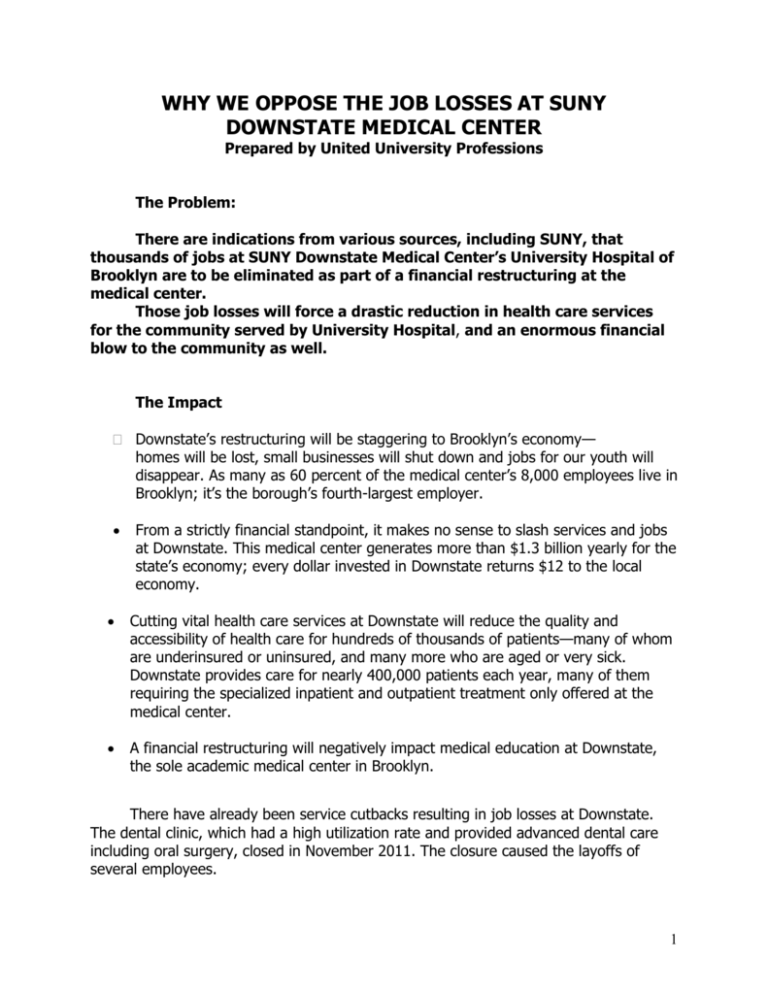
WHY WE OPPOSE THE JOB LOSSES AT SUNY DOWNSTATE MEDICAL CENTER Prepared by United University Professions The Problem: There are indications from various sources, including SUNY, that thousands of jobs at SUNY Downstate Medical Center’s University Hospital of Brooklyn are to be eliminated as part of a financial restructuring at the medical center. Those job losses will force a drastic reduction in health care services for the community served by University Hospital, and an enormous financial blow to the community as well. The Impact Downstate’s restructuring will be staggering to Brooklyn’s economy— homes will be lost, small businesses will shut down and jobs for our youth will disappear. As many as 60 percent of the medical center’s 8,000 employees live in Brooklyn; it’s the borough’s fourth-largest employer. From a strictly financial standpoint, it makes no sense to slash services and jobs at Downstate. This medical center generates more than $1.3 billion yearly for the state’s economy; every dollar invested in Downstate returns $12 to the local economy. Cutting vital health care services at Downstate will reduce the quality and accessibility of health care for hundreds of thousands of patients—many of whom are underinsured or uninsured, and many more who are aged or very sick. Downstate provides care for nearly 400,000 patients each year, many of them requiring the specialized inpatient and outpatient treatment only offered at the medical center. A financial restructuring will negatively impact medical education at Downstate, the sole academic medical center in Brooklyn. There have already been service cutbacks resulting in job losses at Downstate. The dental clinic, which had a high utilization rate and provided advanced dental care including oral surgery, closed in November 2011. The closure caused the layoffs of several employees. 1 The administration also shut down the clinical department of neurosurgery in March 2012, causing more job losses. Finally, Downstate’s radiation/oncology unit has cut its services; SUNY officials have indicated they plan to close the unit, although they have not announced when. All of the foregoing raises several critical questions with regard to targeting University Hospital for these major reductions—questions that have not been answered: Where is the analysis to demonstrate that the population currently served by University Hospital will have appropriate access to healthcare? What analysis exists to demonstrate that sufficient inpatient services would be available to accommodate those in need from the University Hospital service area or that health care for children and the elderly would be available? How can the removal of healthcare services be justified at University Hospital? Where will those 130,000 clinic visits be provided? How and where will the 70,000 emergency room patients be treated? Where are the financial statements detailing the revenues (specifically the source of those revenues) and expenditures at Downstate, the LICH campus and University Hospital? Where are the most recent audits done on these facilities? Those financial plans are needed to determine why University Hospital will apparently bear the brunt of any reductions associated with the restructuring. It is apparent that the goal is to diminish services at University Hospital to the point where only some ambulatory and or outpatient programs exist—while seeking to fully protect and enhance services at the Cobble Hill site. Such action will significantly increase the unemployment rate in the University Hospital community and negatively impact the area’s economy. This area already has one of the highest unemployment rates in the state. If this restructuring plan isn’t stopped, the negative impact on the local economy will have been caused by SUNY, and not by the general condition of the state and national economies. Poor financial decisions Downstate’s financial troubles can be directly attributed to its SUNY-sanctioned 2010 merger with the former Victory Memorial Hospital (now Bay Ridge) and 2011 acquisition of the Long Island College Hospital (LICH). 2 Both hospitals were on the verge of bankruptcy when they were absorbed by Downstate. Victory owed $90 million to creditors in 2007 (The Brooklyn Paper, Nov. 17, 2007; http://bit.ly/JxfnVa). LICH was $170 million in debt when Downstate’s acquisition process began, (The New York Times, Oct. 14, 2010; http://nyti.ms/K4YgNm). Subsequent state budget reductions and federal health care mandates, along with the costs of necessary upgrades and maintenance to LICH, Bay Ridge, and existing facilities, increased Downstate’s financial burden. In 2011, Downstate received final approvals to acquire LICH, which became part of SUNY. SUNY maintained to the Comptroller and the State Hospital Review and Planning Council that the acquisition was necessary to maintain the viability of Downstate’s academic medical center at University Hospital and to ensure that the medical school operated by Downstate could continue its operations. Prior to its acquisition by Downstate, LICH was operated by Continuum Health Partners Incorporated; Continuum ran a consortium of hospitals that also included Beth Israel and St. Luke’s/Roosevelt. At the time of acquisition, it was well known that LICH was on the verge on bankruptcy; in fact, state Health Care Efficiency and Affordability Law of New York State (HEAL NY) funding was provided so LICH could satisfy a small portion of its outstanding liabilities, notably malpractice premium payments which had been delayed for more than a year. It was well known at the time that Downstate’s medical school and University Hospital, even though they were operating in the black, were in need of additional state funding prior to Downstate’s acquisition of LICH. Nevertheless, Downstate was permitted to acquire a near-bankrupt hospital without state guarantees to ensure the financial viability of either or both institutions. Subsequent state budget reductions and federal health care mandates, along with the costs of necessary upgrades and maintenance to LICH, Bay Ridge, and existing facilities, increased Downstate’s financial burden. Downstate’s employees should not pay the price for poor financial decisions by SUNY. Also, it should be noted that University Hospital revenues are subsidizing the operations of its medical school – perhaps up to $100 million annually or more. If University Hospital’s ability to generate revenues is diminished, the survival of its medical school is doubtful. LICH was, and continues to be underutilized (beds filled). In contrast, from 20052009, occupancy rates increased at University Hospital by more than 17 percent, 3 the emergency department grew by over 25 percent, and general clinic visits grew by 32 percent, to more than 130,000 patients annually. Importance to the community Downstate is the only academic medical center in Brooklyn. More than 1,600 students—many of them people of color—are educated annually in Downstate’s colleges of Medicine, Nursing and Public Health. The medical school has one of highest minority student populations in the country. More than 80 percent of physicians who graduate from Downstate remain in New York and provide vital primary care services to patients in New York City, particularly in Kings County. Just under a half a million people live in University Hospital’s primary service area. This service area includes portions of Bedford Stuyvesant, Crown Heights, Flatbush, Canarsie, and Flatlands. Health professional shortages are particularly acute in the neighborhoods of Bedford Stuyvesant and Crown Heights. This is exactly the type of neighborhood where the state should be increasing services and creating jobs, not abandoning people in need. Central Brooklyn has one of Brooklyn’s highest unemployment (10 percent) and foreclosure rates. Over a quarter of the population in University Hospital’s primary service area lives in poverty, earning less than $15,000 annually. It is located in a section in Brooklyn where most of the patients it serves are uninsured or underinsured. About 85 percent of all patients admitted to University Hospital are AfricanAmerican, almost all from the zip codes in the eastern half of the borough: Central Brooklyn, East New York, Flatbush, Canarsie, and Mill Basin. One third of admissions are to seniors; one in 10 admissions is of someone 80 years or older. University Hospital is a key component in Central Brooklyn, serving the health needs of hundreds of thousands of residents. University Hospital’s Emergency Room alone tends to the critical needs of more than 80,000 residents per year. Emergency room visits increased by 25 percent from 2005 through 2009. As a state hospital, University Hospital must provide treatment to everyone, whether or not they have insurance and regardless of their ability to pay. State support for these institutions was approved more than 20 years ago to help cover those costs. Should this facility close, the other area hospitals could not handle the increased number of patients. Travel times for emergency care to more distant emergency rooms and waiting times to see a health care 4 provider once in a hospital would increase dramatically. Patients in need of treatment for critical conditions would be put at extreme risk. It is not only in the area of emergency care that the closing of inpatient services at University Hospital would disrupt health care in Central Brooklyn. The hospital is a 376-bed facility with advanced diagnostic and treatment centers, three satellite primary care centers, a dialysis center, the Medical Research Library of Brooklyn, dormitories, and a student center. It houses the Advanced Biotechnology Park and Biotechnology Incubator (the first to be built in New York City in more than 10 years), and the Brooklyn Center for Health Disparities. The hospital’s Division of Transplantation has performed more than 4,000 life-saving kidney transplants since 1965 through its Downstate Transplant Program. The program is one of the largest and most active of its kind in New York. UHB also has the statedesignated Regional Perinatal Center, a 29-bed state-of-the-art unit that provides Level 3 care 24 hours a day. More than 850 neonates are cared for annually in the center. Other services include cardiothoracic surgery, high-risk maternity care, a stateof-the-art neonatal unit, dialysis procedures, free health screenings, ambulatory surgery, and 75 community outreach programs—including the Center for Community Health Promotion and Wellness. The hospital has shown consistent growth in its inpatient and other clinical services. From 2005 to 2009, discharges increased by 13.2 percent, occupancy rates were up by 17.5 percent, and general clinic visits grew by 32 percent to more than 130,000. An education pipeline Hundreds of doctors, nurses, and other health care professionals are trained at Downstate’s schools each year. More Downstate-trained doctors practice medicine in New York City than from any other medical school. One in every three doctors in Brooklyn graduated from SUNY Downstate. More than half of Brooklyn’s doctors in certain specialties have been trained at the center. Simply put, the doctors and nurses trained at Downstate stay in Brooklyn and provide the health care for the largest county in New York state. In addition, the hospital is part of the training programs of nearly 900 graduate physicians (residents and fellows) who are pursuing specialty training. These training programs depend on University Hospital: 5 o Anesthesiology o Dermatology o Emergency Medicine, with fellowships in Disaster Medicine Geriatric Medicine o International Emergency Medicine o Pediatric Emergency Medicine Ultrasound o Family Practice, with fellowships in Faculty Development Women’s Health o Internal Medicine, with fellowships in Allergy and Immunology Cardiovascular Medicine Digestive Diseases Endocrinology Hematology Infectious Diseases Pulmonary Diseases Critical Care Rheumatology o Obstetrics and Gynecology, with fellowships in Gynecologic oncology o Ophthalmology o Orthopedic Surgery o Otolaryngology o Pathology o Pediatrics with fellowships in Adolescent Medicine Allergy and Immunology Pediatric Infectious Disease Pediatric Gastroenterology Pediatric Pulmonology o Physical Medicine & Rehabilitation o Psychiatry o Radiology o Surgery o Urology With the loss of clinical faculty resulting from a closure of inpatient services or significant downsizing, these programs would have to scale back drastically. Some programs would be discontinued; others would shrink in size. 6 Pioneering medical research Downstate is considered the birthplace of magnetic resonance imaging; the first human MRI studies were performed at Downstate. A Downstate scientist, Dr. Robert F. Furchgott, won the Nobel Prize in 1998 for identifying the fundamental role that nitric oxide plays in the regulation of cardiovascular function. School of Graduate Studies faculty members work closely with the clinical faculty of University Hospital on important research projects that bring in substantial federal funding and produce important research breakthroughs. A partial listing of current research areas in which University Hospital physicians are partners with the basic scientists includes: o o o o o o o o o o o o o o o o o o o o o o o o o o o Alcoholism and drug addictions Allergies Asthma Brain controlled prosthetic limbs Breast cancer Cardiac rhythms Colon cancer Epilepsy Fragile X syndrome Health disparities HIV/AIDS Hypercholesterolemia Immunology: asthma, allergy, autoimmune disorders (lupus, rheumatoid arthritis) Intra-cranial drug delivery devices Lung cancer Memory disorders Migraine Multiple myeloma/lymphoma Muscle research Myeloma Neurodegenerative disorders, including Alzheimer’s and stroke Nicotine addiction Nutrition and metabolism Parkinsonism Prostate cancer Protecting the brain during surgery Sickle cell disease 7 o Sleep disorders o Traumatic brain injury o Vision loss The success of these collaborations depends on the close proximity of the clinicians to the basic scientists. Loss of the University Hospital inpatient services with the associated attempted relocation of the physician staff would cripple these partnerships, block grant funding, and hinder research. In addition, University Hospital has begun major research efforts into health policy and the shift of patient care to ambulatory settings. The findings from this work will allow University Hospital to become a leader in ambulatory care that prevents hospitalization and improves the quality of hospital care. University Hospital maintains more than 75 outreach services to the communities it serves. These services screen and educate Brooklynites to help keep them healthy and to bring them to care earlier. University Hospital is Downstate’s teaching hospital, with 8 intensive care and step-down units, 12 operating rooms, an emergency services department, a diagnostic and ambulatory surgery facility, an ambulatory care center with 75 clinics, 3 satellite Health Centers, and 376 beds available for patients. The hospital is staffed by 8,000 faculty and medical professionals. University Hospital also has the following centers and services for patients: STAR Health Center Neighborhood Health Centers Center for Community Health and Wellness Non-blood Program In addition to these centers, the University Hospital of Brooklyn provides the following clinics for patients: Anesthesiology Asthma Center Dermatology Emergency Medicine Family Practice Infectious Diseases Medicine Nephrology Obstetrics & Gynecology Oncology Ophthalmology Orthopaedics Otolaryngology Pathology 8 Pediatrics Physical Medicine & Rehabilitation Psychiatry Radiology Radiation Specialty Centers Surgery Transplant Urology More jobs, not job cuts for Brooklyn In his State of the State address, Gov. Andrew Cuomo said job creation is one of his highest priorities. Brooklyn needs more jobs, not job layoffs. These layoffs will leave thousands of Brooklynites without jobs, decimate Brooklyn’s economy, and negatively impact health care services for thousands who rely on Downstate for health care. This is an opportunity to invest in the community and continue the vital health care services that thousands of Brooklyn residents depend on. Conclusion It makes no sense for the state to take an action that will so negatively impact a community that needs more, not less, proactive state assistance. The means to resolve this problem exist, and actions to remedy these issues must be implemented. Our members should not have to pay the price for the state’s poor financial decisions. 9
